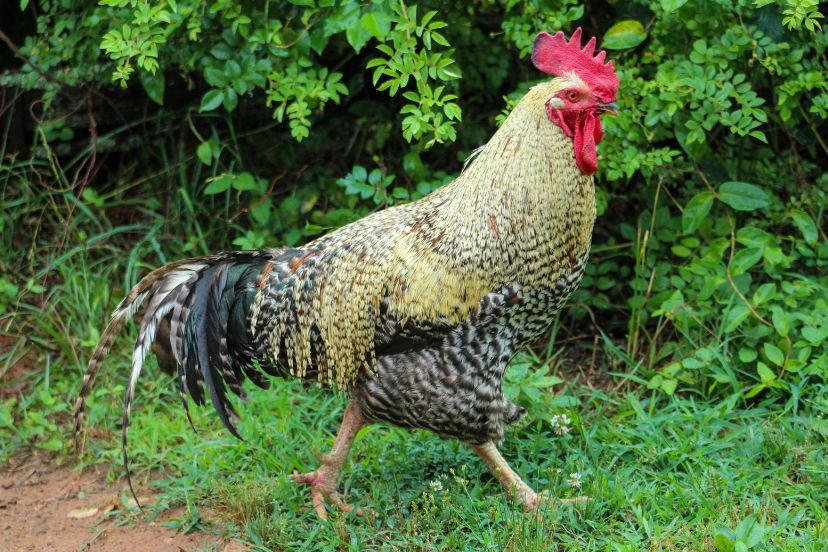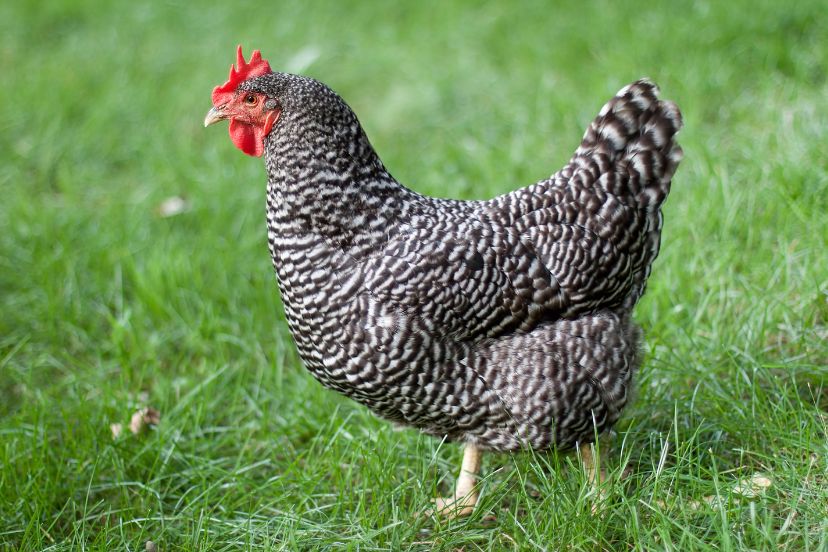Barred Rock Rooster vs Hen: Unique Roles and Differences
Ever since I ventured into the world of poultry keeping, the Barred Rock breed has always been a subject close to my heart. Not just because of their attractive feather patterns but the distinct differences between the roosters and hens have always piqued my curiosity. This iconic breed with its contrasting characters between genders, barred rock rooster vs hen, which one should I choose for my flock?
Growing up, I always loved the speckled look of Barred Rocks. Their unique appearance always stood out in a flock. But as I delved deeper into my poultry passion, I realized it wasn’t just their looks—each gender, rooster, and hen, brought something unique to the table.
So, what makes the rooster different from the hen? Well, plenty!
| Barred Rock Rooster | Barred Rock Hen |
| larger and robust in size | smaller and compact in size |
| approximately 7-8 pounds (3-3.6 kg) | approximately 6-7 pounds (2.7-3.2 kg) |
| does not lay eggs | medium to large eggs |
| elevated black & white barring | black & white barring |
| larger comb, wattles, and spurs | smaller comb, wattles, and spurs |
| territorial, assertive & protective | calm, less aggressive & docile |
| crow to mark territory & alert flock | more quite with minimal vocalization |
| alarm system, protection & mating | flock dynamics & egg production |
Barred Rock Rooster vs Hen: Physical Differences
| Read Next: |
California White Chickens: The Feathered Wonder of the West
Size and Stature
One of the first things that even a novice poultry enthusiast will notice when comparing Barred Rock roosters to hens is the stark difference in their size and stature.

Rooster’s Size and Dominance
Roosters, by nature, are built to be more dominant and visible. Their larger size isn’t just about physical prowess but is also an embodiment of their role within the flock. This bigger size is not unique to Barred Rocks but is seen in many chicken breeds. In the world of chickens, size often equates to dominance, and roosters leverage their size to maintain order within the flock and to ward off potential threats.
Upright Stance (A Symbol of Vigilance)
Beyond just size, the posture of a rooster is another distinguishing factor. Roosters have an upright stance, standing tall with an elevated neck and chest puffed out. This isn’t just for show. This posture allows them better visibility over their territory. It acts as a lookout stance, enabling them to spot potential dangers, like predators, and alert the flock in time. The raised posture also aids in projecting their crowing farther, asserting their dominance and marking their territory.
Tail Feathers
Now, about those flamboyant tail feathers – they are indeed a spectacle. The long, flowing, often glossy tail feathers, sometimes referred to as “sickle feathers,” are a definitive characteristic of many roosters. These feathers can arch over the back and cascade gracefully downward. In some breeds and specific individuals, they can be incredibly long and vividly colored. For the Barred Rock rooster, while the color remains within the barred pattern, the elongation and display of these feathers add to their majestic appearance.
These tail feathers play multiple roles:
- Attraction: Just like the plume of a peacock, the tail feathers of a rooster can play a role in attracting hens. It’s a sign of good health and genetics.
- Dominance: A full set of tail feathers can make a rooster appear even larger, helping establish his position within the flock’s hierarchy.
- Defense: In confrontations, a rooster will fan out his tail, making himself appear larger and more intimidating to adversaries.
In essence, while the barred pattern of the Barred Rock rooster and hen might be similar, the size, upright stance, and the extravagant tail feathers of the rooster set him apart, making him a distinct and majestic figure in the poultry world.
Barred Rock Rooster vs Hen: Behavioral Differences
Sounds and Calls
When it comes to the vocal repertoire of the Barred Rock chickens, one can find a stark difference between the genders. It’s an acoustic world of contrasts that offers fascinating insights into the social structures and individual roles within the flock.
Roosters, as we often know, are the heralds of dawn. Their crow, a robust, clear, and resonant call, serves multiple purposes. Beyond just signaling the break of day, it’s a territorial proclamation. When a rooster crows, he’s asserting his dominance, marking his territory, and signaling to potential rivals to steer clear. It’s like a lion’s roar in the avian kingdom.

Hens, on the other hand, are not silent spectators. They have their vocal expressions, albeit different in purpose and tone. A hen might ‘cluck’ in gentle rhythms, signaling contentment or calling her chicks. There’s also the triumphant ‘egg song’—a hen’s proud announcement post-laying. However, you’d seldom, if ever, hear a hen attempting the powerful crow of a rooster. Her communications are more nuanced, often reflective of her immediate surroundings or needs.
Social Dynamics (Protectors and Caretakers)
Dynamics within a flock offer a captivating study in avian sociology. The roles are defined, behaviors distinct, and interactions intricate.
Roosters, with their larger build and vigilant posture, naturally assume the role of protectors. They’re like the knights of the coop—always on guard, always ready. It’s not uncommon to see a rooster scanning the horizon for potential threats. And when danger lurks, be it a sneaky fox or a hovering hawk, the rooster is often the first to sound the alarm. His protective instinct doesn’t stop at mere warnings. Roosters are known to physically position themselves between perceived threats and their hens, ready to defend, even if it means putting themselves in harm’s way.
Hens, while no less vital to the flock’s social fabric, play a different role. If roosters are the knights, hens are the heart of the coop. They’re the caregivers, the nurturers. They form close-knit bonds with other hens, often seen foraging together, sharing food finds, or indulging in communal dust baths. This nurturing spirit extends to their chicks, with mother hens showcasing extreme protectiveness, warmth, and care.
In essence, the Barred Rock rooster and hen, while sharing the same breed lineage, exhibit behavioral traits that are not just complementary but also essential for the harmony, safety, and well-being of the flock. Their symbiotic relationship—a blend of protection and nurturing—ensures the flock’s survival and cohesion.
Advantages of Keeping Each
A rooster brings a dynamic presence. They can help keep peace within the flock, and their early morning crows, though sometimes loud, have an undeniable rural charm. Plus, if you’re looking into breeding, a rooster is a must.
Hens are your egg producers. Reliable and consistent, they provide fresh eggs almost daily. They’re generally more docile and, in many ways, the backbone of any poultry endeavor.
Barred Rock Rooster vs Hen: Which One to Choose?
If you’re new to poultry, starting with hens might be best. They’re easier to manage and provide the immediate reward of fresh eggs. But if you’re looking to add some flair and dynamics (and maybe a tad bit of drama) to your flock, a rooster could be just the ticket. Personally? I say why not both!
FAQs
Can I keep more than one rooster in a coop? It’s possible, but watch for signs of aggression. They can be territorial.
How many hens per rooster is ideal? Typically, a ratio of 8-10 hens per rooster is recommended.
Do hens lay eggs without a rooster? Yes, they do! However, the eggs won’t be fertilized.
Is there a difference in taste between rooster and hen eggs? Hens lay the eggs, so there’s no “rooster egg.” However, many claim there’s a difference in taste between a young hen’s egg and an older hen’s.
How long do Barred Rocks live? With good care, they can live 6-8 years, sometimes even longer.




